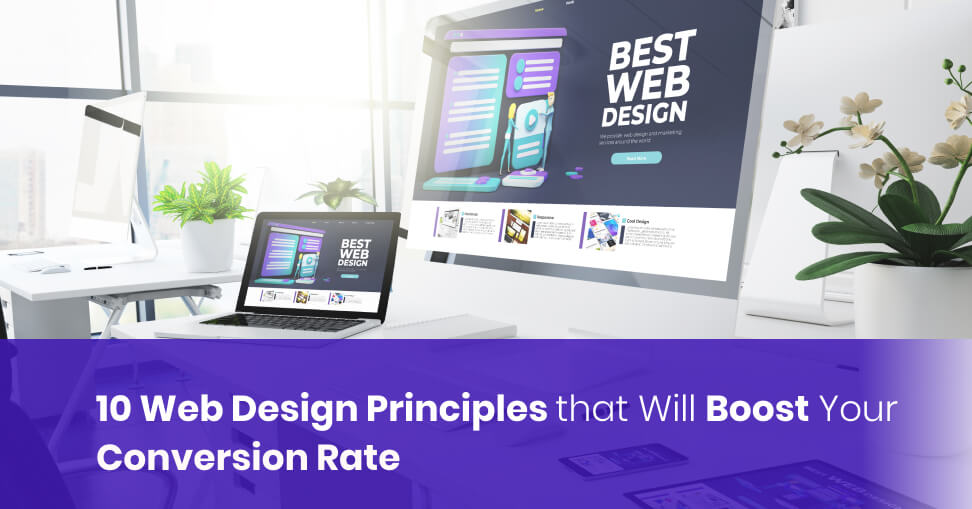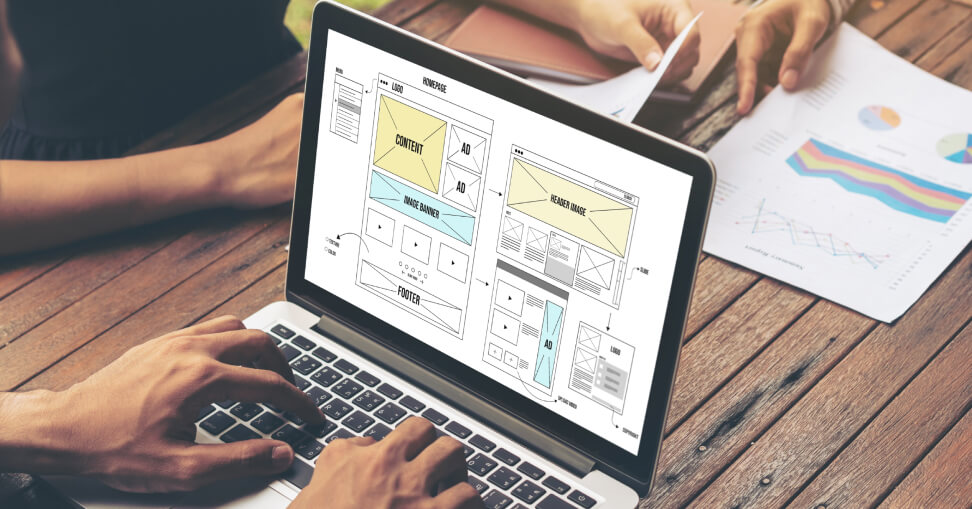10 Web Design Principles that Will Boost Your Conversion Rate
- Home
- 10 Web Design Principles that Will Boost Your Conversion Rate

Welcome to the digital age, where a well-designed website can make or break your online presence. In today’s competitive market, it’s not enough to simply have an attractive website – you need one that converts visitors into customers. That’s where web design principles come in. These guiding principles help a kolkata web design company to create a user-friendly and visually appealing website that captivates your audience and drives them towards taking action.
you’re a small business owner looking to boost sales or an aspiring entrepreneur trying to establish your brand online, mastering these 10 web design principles will be the key to your success. So let’s dive in and discover how purposeful design, intuitive navigation, compelling calls-to-action, and other powerful techniques can transform your website into a conversion machine!
Purposeful design
Purposeful design is the foundation of a successful website. Your business goals and target audience should be aligned with a visually appealing and user-friendly interface. When designing your website, every element should serve a purpose – from the layout to the color scheme and even the placement of buttons.
One key aspect of purposeful design is understanding your target audience. By knowing who you are designing for, you can tailor your website to meet their needs and preferences. For example, if you’re targeting young professionals, a sleek and modern design may be more effective than a traditional one.
Another crucial factor in purposeful design is optimizing for usability. Your visitors should be able to navigate through your site effortlessly, finding what they need without any confusion or frustration. This means incorporating intuitive navigation menus, clear headings, and logical categorization of content.
In addition to aesthetics and usability, purposeful design also considers conversion optimization. Every element on your website should guide visitors towards taking action – whether it’s making a purchase, filling out a form, or subscribing to your newsletter. By strategically placing calls-to-action throughout your site and ensuring they stand out visually, you can boost conversions significantly.
Remember: Purposeful design isn’t just about looking good; it’s about creating an immersive experience that engages users while driving them towards their desired actions. So take the time to understand your audience’s needs and motivations before diving into web design – because when done right, purposeful design can transform mere visitors into loyal customers!
Keep it simple
When it comes to web design, simplicity is key. A cluttered and complex website can overwhelm visitors and lead them to click away in frustration. That’s why it’s important to keep your design clean and straightforward.
One way to achieve simplicity is through minimalism. Use a limited color palette, avoid excessive graphics or animations, and focus on clear and concise content. By simplifying your design elements, you create a visually appealing website that is easy for users to navigate.
Another aspect of keeping it simple is by streamlining your navigation. Make sure that your menu items are clearly labeled and organized logically. Avoid overwhelming visitors with too many options or hidden menus.
In addition, consider the use of white space in your design. White space not only helps improve readability but also gives the eye room to breathe. It allows important elements like calls-to-action or images to stand out more effectively.
Remember, simplicity doesn’t mean boring – it means creating an intuitive experience for users where they can easily find what they’re looking for without unnecessary distractions or confusion.
So when designing your website, always strive for simplicity – it will make a big difference in improving user experience and ultimately boosting your conversion rate!
Intuitive navigation
Intuitive navigation is a crucial element of web design that can greatly impact your conversion rates. When visitors come to your website, they should be able to easily find what they are looking for without any confusion or frustration.
To achieve intuitive navigation, it’s important to organize your website in a logical and user-friendly manner. This means having clear and concise menus that clearly indicate the different sections and pages of your site. Each section should be labeled with descriptive labels that accurately describe the content.
In addition, consider implementing breadcrumb navigation, which shows users their current location within the site hierarchy. This can help users backtrack if they need to find information on a previous page.
Another effective technique is using visual cues such as arrows or hover effects to guide users through the website. These subtle hints can draw attention to important elements or indicate clickable areas.
Make sure your website is responsive and mobile-friendly. With more people accessing the internet via smartphones and tablets, it’s essential that your site adapts seamlessly across different devices.
By prioritizing intuitive navigation in your web design strategy, you’ll provide a positive user experience that encourages visitors to explore further and ultimately convert into customers.

Use calls to action
Calls to action (CTAs) are a crucial element of web design that can significantly boost your conversion rate. A well-placed and compelling CTA can guide visitors towards the desired action, such as making a purchase, signing up for a newsletter, or downloading an ebook.
When designing CTAs, it’s important to make them visually appealing and attention-grabbing. Use contrasting colors that stand out from the rest of your website’s color scheme. This will draw the user’s eye directly to the CTA button or link.
It is equally important to use the right language in your CTAs. Tell users exactly what action they need to take, in a clear and concise manner. Instead of using generic phrases like “click here” or “submit,” try using more specific wording that aligns with their goals or interests.
To create urgency and encourage immediate action, consider adding time-sensitive words like “limited time offer” or “exclusive deal.” This can motivate users to act quickly before they miss out on something valuable.
Remember that placement matters too! Position your CTAs strategically throughout your website where they are easily visible and accessible. Consider placing them above the fold so users don’t have to scroll down to find them.
By incorporating effective calls-to-action into your web design strategy, you can guide visitors towards taking actions that ultimately lead to higher conversion rates for your business.
Use of whitespace
Whitespace, also known as negative space, is an essential design element that often gets overlooked. An empty space between and around elements on a webpage is called a whitespace. Many people mistakenly think that filling every inch of their website with content or images will make it more visually appealing. It is far from the truth, however.
In reality, whitespace plays a crucial role in web design because it helps to improve readability and user experience. By giving your content room to breathe, you create a sense of balance and clarity for visitors. When used effectively, whitespace can guide users’ attention to important elements such as headlines or calls to action.
Moreover, whitespace enhances the overall aesthetics of a website by creating a clean and organized look. It gives your site a sense of elegance and professionalism while making it easier for users to navigate through the information provided.
Remember that less is more when it comes to using whitespace effectively. Avoid cluttering your pages with unnecessary text or images; instead, focus on providing valuable content in digestible chunks separated by ample negative space.
By incorporating proper use of whitespace into your web design strategy, you can significantly boost your conversion rate by creating an enjoyable browsing experience that engages visitors and encourages them to take action.
Use of visual cues
Visual cues play a crucial role in guiding visitors and directing their attention towards important elements on your website. They can be used strategically to enhance the user experience and increase conversion rates.
One effective way to use visual cues is through the placement of arrows or lines that point towards key areas or actions you want users to take. These visual indicators help draw attention and lead visitors towards desired goals, such as filling out a form or making a purchase.
Another powerful visual cue is the use of contrasting colors. By highlighting important elements with vibrant colors while using more muted tones for less significant elements, you can create a clear distinction that captures users’ attention.
Additionally, images can serve as strong visual cues by conveying information quickly and effectively. High-quality visuals that align with your brand’s messaging not only grab attention but also establish credibility and trustworthiness.
When designing your website, consider incorporating motion-based cues such as animations or sliders. Motion has the ability to captivate users’ interest and guide them through different sections of your site.
Incorporating these visual cues into your web design will not only make it visually appealing but also help direct visitors towards taking desired actions leading to higher conversion rates.
Use typography to your advantage
plays a crucial role in web design, and when used effectively, it can greatly enhance the user experience and boost your conversion rate. Here are some key principles to keep in mind when using typography on your website.
Choose fonts that align with your brand identity and convey the right message. Whether you opt for a sleek sans-serif or an elegant serif font, consistency is key throughout your site.
Next, consider the hierarchy of typography. Use larger font sizes for headlines or important information to grab attention, while smaller font sizes can be used for body text. This helps guide users through the content and highlights what’s most important.
Another important aspect is readability. Make sure your fonts are legible on different devices and screens. Using intricate or overly decorative fonts may hinder readability.
Whitespace also plays a vital role in typography. Give your text room to breathe by incorporating ample whitespace between lines, paragraphs, and sections of text. This not only improves readability but also lends a clean and organized look to your website.
Furthermore, don’t be afraid to experiment with different font weights and styles to create visual interest within your content. Bold or italicized text can draw attention to specific words or phrases that you want users to notice.
Ensure responsive design for mobile devices as well. Typography should adapt seamlessly across various screen sizes without sacrificing legibility or visual appeal.
By considering these principles when utilizing typography on your website, you can create an engaging user experience that not only captures attention but also drives conversions.
Use of social proof
Social proof is a powerful tool that can significantly boost your conversion rate. When visitors see that others have had positive experiences with your product or service, it creates trust and confidence in your brand. One effective way to incorporate social proof into your web design is by showcasing customer testimonials.
Testimonials provide real-life examples of how your product or service has benefited others. Include quotes from satisfied customers along with their name and photo to add credibility. Another form of social proof is displaying the number of customers or subscribers you have served, which shows that many people trust and rely on your business.
Another great method is to use case studies or success stories on your website. These demonstrate how you have helped clients achieve their goals and overcome challenges. By showcasing these achievements, potential customers will be more likely to believe in the value you offer.
Additionally, including reviews from reputable sources such as industry experts or well-known publications adds further validation to your brand’s credibility. This helps build trust among new visitors who may not be familiar with your business yet.
Incorporating social proof into your web design can greatly influence visitor behavior and increase conversions. By leveraging testimonials, case studies, reviews, and other forms of evidence that showcase positive experiences with your brand, you can create a sense of trust and reliability that encourages visitors to take action
Use of testimonials
When it comes to boosting your conversion rate, testimonials can be a powerful tool. In today’s digital age, potential customers often rely on reviews and feedback from others before making a purchase decision. By incorporating testimonials into your web design, you can build trust and credibility with your audience.
One way to use testimonials effectively is by placing them strategically throughout your website. Consider featuring them prominently on your homepage or product pages where they will catch the attention of visitors. Make sure the testimonials are genuine and highlight specific benefits or results that customers have experienced.
Another effective technique is to include photos or videos alongside the testimonials. This adds authenticity and allows potential customers to connect with real people who have had positive experiences with your business.
In addition, consider using customer testimonials as social proof on your landing pages or checkout process. Seeing positive feedback from satisfied customers can help reassure hesitant buyers and increase their confidence in purchasing from you.
Remember to regularly update and refresh your testimonial content so that it remains current and relevant. And don’t forget to ask for permission from customers before using their words as testimonials – this shows respect for their privacy and builds further trust with both existing and potential clients.
By harnessing the power of testimonials in web design, you can enhance the overall user experience, instill confidence in potential customers, and ultimately boost conversions for your business.
Now let’s move on to our next web design principle: making your website mobile-friendly!
Make your website mobile-friendly
The importance of having a mobile-friendly website cannot be overstated in this digital age. With more and more people accessing the internet through their smartphones and tablets, it is crucial for businesses to adapt their web design to cater to these users.
A mobile-friendly website not only provides a seamless browsing experience for your visitors but also plays a significant role in boosting your conversion rate. When potential customers can easily navigate your site on their mobile devices, they are more likely to stay engaged and take action.
To make your website mobile-friendly, consider implementing responsive design principles. This means that your site will automatically adjust its layout and content based on the screen size of the device being used. By doing so, you ensure that all elements are properly displayed and easily accessible regardless of whether someone is viewing your site on a smartphone or desktop computer.
Another important aspect of ensuring mobile-friendliness is optimizing page load speed. Mobile users tend to have less patience when it comes to waiting for web pages to load. Therefore, it is essential to optimize images, minimize code bloat, and leverage caching techniques to improve overall performance.
Additionally, pay attention to font sizes and touch targets on your mobile site. Text should be easy-to-read without zooming in, while buttons or links should be large enough for users with varying finger sizes or accuracy levels.
By making your website mobile-friendly, you open up new avenues for reaching potential customers and maximizing conversions. So don’t neglect this crucial aspect of web design if you want your business to thrive in today’s digital landscape!
Remember that effective web design goes beyond mere aesthetics – it focuses on creating an intuitive user experience that drives conversions.
Recent Posts
- How to Optimize Your Google My Business Listing for Local SEO Success
- Content is King: Crafting Shareable Content in the Digital Age
- Essential Strategies for E-commerce Success
- Secrets of Instagram Success: Mastering Stories, Hashtags, and Engagement
- Stand Out Locally: Supercharge Your Business with Local SEO
- The Power of E-A-T: How Google’s Algorithm Emphasizes Expertise, Authoritativeness, and Trustworthiness
- Sweet Treats, Sweet Designs: How to Make Your Sweets Boxes Stand Out
- 10 Signs of a Top-Notch Logo Design Company to Look For
- How To Design A Creative Logo For Your Business: The Ultimate Guide 2024
- Video Impact: Elevating Brand Stories, Amplifying Audience Engagement
